Page 30 of 33 pages « First < 28 29 30 31 32 > Last »
Brush-pot
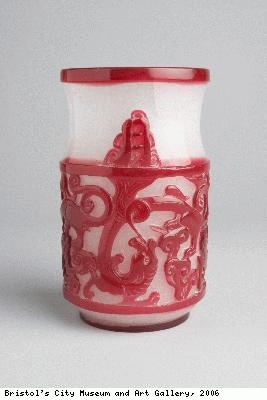
Description:
Pots of this shape were used for storing brushes with the tips up to avoid damaging them. This one has a design of interlaced dragons and the Chinese characters for ‘sun’ and ‘moon’. Together these characters also stand for the concepts of yin and yang, the ancient Chinese theory of the two opposite and complementary principles in nature.
Glass, carved overlay
Height: 12.3 cm, diameter: 7.2 c
Chinese Description:
龙纹笔筒 中国,清代,约1800-1900 笔筒可供倒放画笔。这只文具刻着龙饰及「日」、「月」二字,示意阴阳并济 — 传统宇宙生成两大元素互相交融而创造出万物。 玻璃,套料雕刻Creator: Unknown
Date: 1800-1900, Qing dynasty
Copyright: Bristol Museums, Galleries & Archives
Object ID:N4668
One of a pair of vases
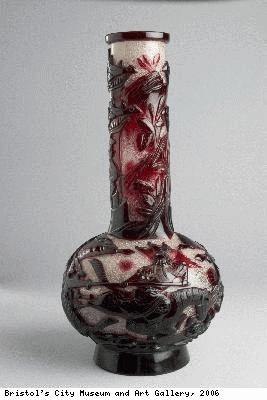
Description:
Vases like this had a decorative use, for example they might be used to decorate the desks of scholars. This vase and its pair, N4654, is carved with scenes from ‘The Romance of the Three Kingdoms’, a popular Chinese drama. The top layer of red glass has been worked in a way that makes the scene look three-dimensional.
Glass, carved in relief
Height: 30.1 cm, diameter: 15.0 cm, neck diameter: 6.0 cm
Four-character mark of Qianlong reign period (1736-1795) in a single thick square, but later in date
Chinese Description:
玻璃瓶一对 中国,清代,约 1800-1900 这类玻璃瓶大多用以装饰家居,如作读书人的案头清赏。这对瓶子的浮雕取材于通俗小说「三国演义」的情节。工匠精雕细琢,使场景更富立体感。 玻璃,套料浮雕 单方框套以「乾隆年制」四字,疑为后人所加Creator: Unknown
Date: 1800-1900, Qing dynasty
Copyright: Bristol Museums, Galleries & Archives
Object ID:N4655
Box, light blue
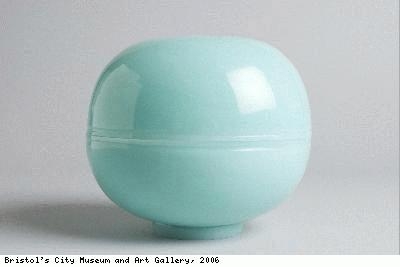
Description:
This box with closely fitted lid was used for holding sweets. Boxes have always been used in China for holding personal items such as mirrors or accessories, or for storage. Boxes were also used for sending food items as gifts. The green colour of this one makes it look like Chinese ceramics with green ‘celadon’ glazes of the Yuan (1280-1368) and Ming (1368-1644) dynasties.
Glass
Base height: 6.1 cm, diameter: 13.1 cm, lid height: 5.5 cm, lid diameter 13.1 cm, combined height: 11.5 cm
Chinese Description:
玻璃盒 中国,清代,约 1800-1900 这盒子配上紧密的盒盖可盛载糖果。古人喜好以盒子摆放镜子等私人配饰,或存放零碎杂物,甚至将食物包装成礼品外送。 玻璃Creator: Unknown
Date: 1800-1900, Qing dynasty
Copyright: Bristol Museums, Galleries & Archives
Object ID:N4586 a, b
Perfume container
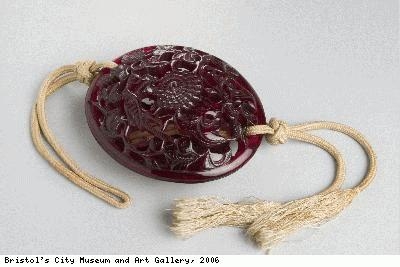
Description:
The glass in this piece has been carved right through to allow the smell of the perfume to filter out. There are some scented sticks inside the container although we do not know when they were put there. The chrysanthemum design symbolises autumn, happy retirement and long life (because people thought the flowers had healing properties). People would have considered the design suitable for older people.
Glass, carved
Height: 11.0 cm, diameter: 9.7 cm, neck diameter: 4.4 cm
Chinese Description:
香盒 中国,清代,约1770-1900 这香盒以菊花为主要装饰,既取秋高气爽的意境,更借喻山林隐逸的逍遥。而菊花可入药,故亦像征长寿。工匠采用透雕法,使容器幽幽的泌出香料的气味。盒内藏有几柱线香,惜现时无法查知何时所放。 玻璃,碾琢Creator: Unknown
Date: 1770-1900, Qing dynasty
Copyright: Bristol Museums, Galleries & Archives
Object ID:N4680
Waste jar
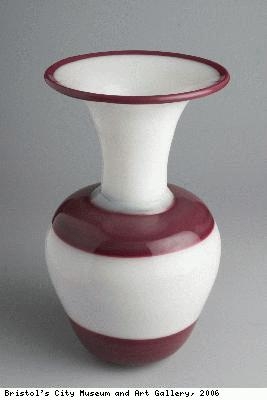
Description:
Waste jars like this were used for the disposal of litter and small amounts of liquid such as tea. In China today the use of these jars or ‘spittoons’ is still part of every day life.
In 1762, the Qianlong Emperor issued an order forbidding the palace workshops to carve reign-marks on waste jars. This piece has no reign-mark and so was probably made after 1762.
Glass, with overlay
Height: 21.9 cm, diameter: 12.7 cm, neck diameter: 12.3 cm
Chinese Description:
渣斗 中国,清朝,约 1735-1762 渣斗用以弃置垃圾或如冷茶等小量汁液。这类渣斗或唾壶仍然是现今中国日常生活的一部份。 套料玻璃Creator: Unknown
Date: about 1735-1762, Qing dynasty
Copyright: Bristol Museums, Galleries & Archives
Object ID:N4681
White bowl with lid
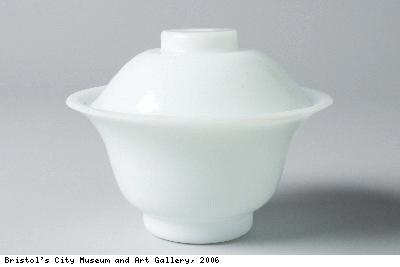
Description:
This bowl with lid was probably used for tea. Because this kind of glass imitates white jade it is sometimes known as ‘poor man’s jade’.
Glass
Base height: 6.0 cm, base diameter: 11.2 cm, lid height: 3.0 cm, lid diameter: 9.3 cm, combined height: 8.6 cm
Chinese Description:
盖碗 中国,清朝,约 1830-1900 这类盖碗大抵用于饮茶。而其材质模仿白玉,更被喻为贫士玉。 玻璃Creator: Unknown
Date: 1830-1900, Qing dynasty
Copyright: Bristol Museums, Galleries & Archives
Object ID:N4693A&B
Dish Qing dynasty (1644-1911)
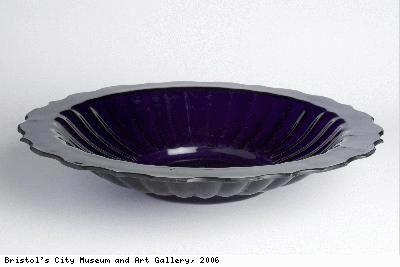
Description:
This chrysanthemum-shaped vessel is based on dishes with a green ‘celadon’ glaze of the Yuan (1280-1368) and Ming (1368-1644) dynasty, which were exported from China to the Middle East. The shape reflects forms admired in that region and may have originated in Middle Eastern metalwork. Similar dishes were also made of lacquer and jade.
Glass, mould-blown glass with wheel-cut rim
Height: 6.0 cm, diameter: 33.5 cm
Chinese Description:
玻璃碟 中国,清代,约1800-1900 元(1280-1368)、明(1368-1644)两代青瓷形多出口至中东一带,式样多反映当地流行的风格。这菊花碟深受其影响,或取材于中东金属工艺的款式。 玻璃,有模吹制、轮刻饰边Creator: Unknown
Date: Qing dynasty (1644-1911)
Copyright: Bristol Museums, Galleries & Archives
Object ID:N4611
Figure of Shouxing, the God of Long Life
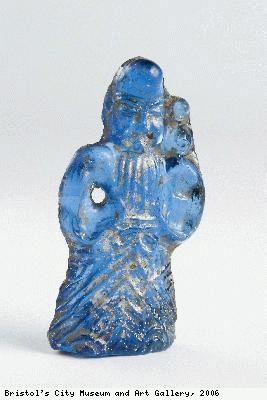
Description:
Shouxing is a popular Daoist deity of long life. He is often shown, as here, carrying peaches, also symbols of long life. Small figures like this could be made relatively quickly using a mould.
Daoism is a Chinese philosophy and religion which is based on the Dao (the Way). It was started by philosophers living 2,500 years ago. The most famous of these is Laozi (‘Old Master’) who is said to have written the famous book Daodejing (The Way and its Power).
Glass, press-moulded
Width: 2.2 cm, length: 5.0 cm, depth: 1.1 cm
Chinese Description:
寿星像 中国,明朝 (1368-1644) 寿星是道教代表长寿的神祇,故常被塑做成手持寿桃的老翁。这尊塑像体型细小,以模型铸造,制作需时不长。 「道」指天地万物的本原,道家思想源于二千五百多年前的中国。 玻璃,模型铸造Creator: Unknown
Date: Ming dynasty (1368-1644)
Copyright: Bristol Museums, Galleries & Archives
Object ID:N4796
Incense burner belonging to altar set
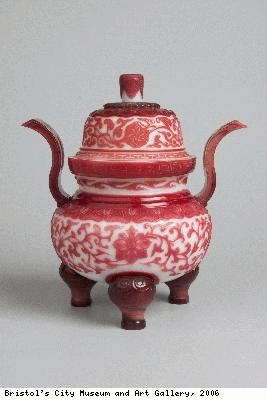
Description:
This incense burner and the two candlesticks (N4676 and N4677) are part of a set for use on a Buddhist altar. They were made during the reign of the Qianlong emperor (pronounced chen-lung), probably in the palace glass workshops. The Qianlong emperor was a follower and strong supporter of Tibetan Buddhism, as were members of his court, and vessels like these would have been in high demand in the palace. Originally the set would have included a pair of flower vases.
Glass, carved overlay
Height: 21.8 cm, diameter: 19.8 cm, neck diameter: 11.5 cm
Four-character mark of the Qianlong reign period (1736-1795)
Chinese Description:
香炉与烛台一对 中国,清乾隆朝 (1736-1795) 这组祭器除了陈列的三件器皿外,原应包括一对花瓶。它们大抵出于乾隆朝的宫廷造办处。 刻有「乾隆年制」四字 玻璃,套料浮雕Creator: Unknown
Date: Qianlong reign period (1736-1795)
Copyright: Bristol Museums, Galleries & Archives
Object ID:N4675
Figure of the Bodhisattva Guanyin
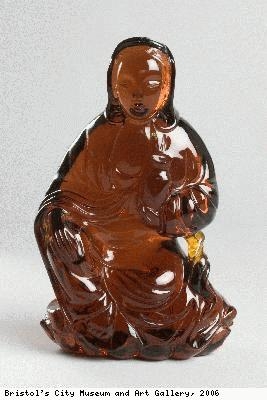
Description:
Guanyin is a Buddhist saint (Bodhisattva) who represents compassion and mercy. She was said to ‘hear the cries of the world’. She was popular with women who prayed to her for children, especially sons. Here Guanyin is shown kneeling, holding a bottle containing the nectar of long life. The clear glass seems to glow, perhaps it would have allowed worshippers to reflect on Guanyin’s power and purity.
Glass, piece-moulded, some wheel-cut detail
Height: 11.2 cm, diameter: 7.1 cm, neck diameter: 4.3 cm
Four-character mark of the Qianlong (1736-1795), possibly added later
Chinese Description:
观音像 中国,清代,约十八至十九世纪 这尊跪姿观音像,手持甘露净瓶,晶莹的玻璃令塑像彷似浑身透光。佛教诸多菩萨中,观世音菩萨广听世人苦难,立志普度众生,代表慈爱。其化身送子观音,更深为女善信所敬仰。 玻璃,铸模,部份经轮刻加工 刻有「乾隆御制」四字,或为后人所加Creator: Unknown
Date: 1700-1800, Qing dynasty
Copyright: Bristol Museums, Galleries & Archives
Object ID:N4621

